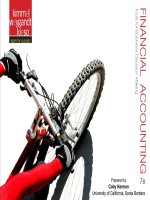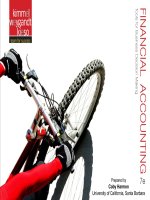Practical financial managment 7e LASHER chapter 14
Bạn đang xem bản rút gọn của tài liệu. Xem và tải ngay bản đầy đủ của tài liệu tại đây (587.02 KB, 63 trang )
Chapter 14 Capital Structure and Leverage
Background
Capital structure - mix of a firm’s debt and equity
– In this chapter preferred stock is considered debt
Financial Leverage - using borrowed money to multiply the effectiveness of
equity
– Financial leverage of 10% means the capital structure is 10% debt and 90%
equity
2
The Central Issue
Can the use of debt (leverage) increase the value of a firm’s equity?
– Can it increase stock price?
Under certain conditions changing leverage can increase stock price
– But an increase in leverage also increases risk
3
Risk in the Context of Leverage
Leverage influences stock price
Measures of overall performance
–
–
EBIT (Earnings Before Interest and Taxes)
–
Earnings per Share (EPS) is
Return on Equity (ROE) is
ROE =
EPS =
NET Income
equity
NET Income
number of shares
4
Redefining Risk for
Leverage-Related Issues
Leverage-related risk is variation in ROE and EPS
–
–
–
Business risk — variation in EBIT
Financial risk — additional variation in ROE and EPS due to financial leverage
Total risk is total variation in ROE and EPS
5
Figure 14-1 Business and Financial Risk
6
Leverage and Risk
Two Kinds of Each
Financial Leverage
Operating Leverage
Associated with capital structure
Associated with cost structure, the firm’s
Causes financial risk.
mix of fixed and variable cost
Influences a firm’s business risk => variation
in EBIT
7
Financial Leverage
Financial leverage may increase stock price
–
–
–
Can improve financial performance, as measured by ROE and EPS
May make performance worse
Always increases risk
8
Table 14-1 Effect of Increasing Financial Leverage when Return on Capital Exceeds After-Tax Cost of
Debt
Replacing equity with debt
reduces Net Income due to
interest expense.
But if profitability is good, it
reduces equity and number of
shares faster than the decline
in Net Income. Hence as debt
increases, both EPS and ROE
rise dramatically.
9
Effect Of Increased Leverage On
Stock Price In Good Times
Based on ROE and EPS performance in good times, investors bid stock price up
as debt is increased from low levels
Effect is eventually mitigated by the increasing financial risk from leverage
Under what conditions will increasing leverage improve ROE and EPS?
10
When Might Financial Leverage Help?
Return on Capital Employed
–
Measures the profitability of operations before financing charges but after taxes on a basis comparable to
ROE
ROCE =
EBIT ( 1 - tax rate )
debt + equity
When the ROCE > the after-tax cost of debt,
more leverage improves ROE and
EPS
When ROCE < the after-tax cost of debt,
more leverage makes ROE and
EPS worse
11
Table 14-2 Effect of Increasing Financial Leverage when After-Tax Cost of Debt Exceeds Return on Capital
When ROCE is less than the after
tax cost of debt, increasing
leverage reduces EPS and ROE .
That, along with increasing risk,
has a very negative effect on
investors and stock price falls.
12
Concept Connection Example 14-1
Managing EPS through Leverage
Will borrowing more money and retiring stock raise Albany’s EPC, and if so, what capital structure will achieve
an EPS of $2?
Concept Connection Example 14-1
Managing EPS through Leverage
Concept Connection Example 14-1
Managing EPS through Leverage
Managing Through Leverage
Under certain conditions management may be able to manipulate
financial results and stock price by changing the firm’s capital structure.
This is true, but must be done cautiously
16
An Alternate Approach (Optional)
Using ratios and information from financial statements to solve for unknown values: algebraic
approach
EPS = ROE × Book Value per share
ROE = Net Income ÷ Equity
Net Income= [EBIT – Interest] (1 – tax rate)
Interest = kd (Debt)
–
Net Income = [EBIT – (kd)(Debt)](1 – tax rate)
Equity = Total Capital – Debt
[EBIT − (k d )(Debt)(1 − T )
EPS =
(Book valueper share)
(Total capital- Debt)
17
Table 14-3 Financial Leverage and Risk
Financial leverage is a two-edged sword
–
–
Multiplies good results into great results
Multiplies bad results into terrible results
18
Putting the Ideas Together—
The Effect on Stock Price
During periods of good performance, leverage enhances results in terms of ROE and EPS
Leverage adds variability (risk) to financial performance when operating results change
These effects push stock prices in opposite directions
19
Real Investor Behavior and
the Optimal Capital Structure
When leverage is low, an increase has a positive effect on investors
At high debt levels, risk concerns overwhelm benefit of enhanced performance
thus additional leverage decreases stock price
As leverage increases, its effect goes from positive to negative
20
Figure 14-2 The Effect of
Leverage on Stock Price
21
Finding the Optimum—
A Practical Problem
1. A firm with good profit prospects and little or no debt is probably missing an
opportunity by not using borrowed money if interest rates are reasonable.
2. For most businesses, the optimal capital structure is somewhere between 30% and
50% debt.
3. Debt levels above 60% create excessive risk and should be avoided.
22
The Target Capital Structure
A firm’s target capital structure is management’s estimate of the optimal capital
structure
23
The Effect of Leverage When Stocks Aren’t Trading at Book Value
Changes in leverage not involving the
purchase of equity at book value are more complex
Repurchasing stock for retirement at prices other than book value will have the same
general impact on ROE, but not necessarily for EPS
EPS = ROE x (book value per share)
24
The Degree of Financial Leverage (DFL)
A Measurement
Financial leverage magnifies changes in EBIT into larger changes in ROE
and EPS
DFL quantifies the effectiveness of leverage by relating relative changes to
EPS and EBIT
EBIT
DFL =
EBIT - Interest
25









